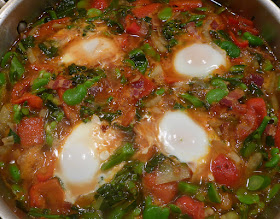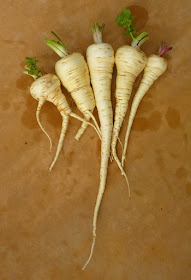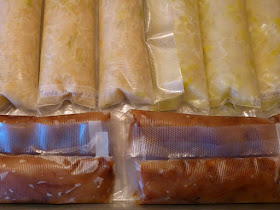There it is, a snapshot of most of the harvests for 2015. I had fun putting together a collage that used most of the photos I used in my Harvest Monday posts for the year. It's not everything that I harvested since I didn't photograph every single harvest, but it gives a pretty good idea of what and how much was coming from the garden through the year. It's arranged in 12 equal sized collages arranged in horizontal rows with the top row showing January harvests and on down through the year to the last row showing December harvests. It wasn't that difficult to put together, I let Picasa do the work of putting together the individual collages - just select the photos and the size of the finished collage and Picasa does the work of arranging the photos. The I arranged the individual collages into rows by month.
So, on to the review. The weather in 2015 was for the most part conducive to plentiful harvests. It warmed up early in the year and stayed warm with the exception of a cool and very foggy May. Then it turned to summer in June, which was actually earlier than usual since we typically get a lot of fog and cool weather in June, July and sometimes into August. "Summer" usually starts round about September here. This year it was warm and too dry for most of the year, downright hot in the fall and well into November, and then it turned cold and wet and has stayed that way since then. Now the prediction is for a wetter than normal winter thanks to
El Niño.
I've been taking forever to work up this post and it's getting to be quite long so I'm going to break it up. I'll start off with the solanums.
 |
Tomatoes of 2015
|
From top left - Top row: Chianti Rose, Spike, Jaune Flamme, Amish Paste. Middle row: Penn State Plum, Caspian Pink. Bottom row: Camp Joy, Sweet Gold, Mavritanskite, Pantano.
Tomatoes. Considering all the years that I've been growing tomatoes you might think that I've figured them out, but I always seem to learn something new. This year I learned that they do not like a 70% Extract of Neem Oil. My tomato plants got heavily infected with more than one type of fungus on their foliage this summer and the leaves were moldy and dying. Neem is a very effective fungicide, I've used it for years on curcurbits with success. So I tried it on the tomatoes and it worked, it stopped the fungus from spreading, but it killed the new flowers. I normally get a second flush of tomatoes that ripen in October and November, last year I harvested 51 pounds in those 2 months. This year I got 2.5 pounds in October and November. The harvest was still good at 201 pounds but could have been better, last year the tomato harvest came to 220 pounds from fewer plants. Lesson learned, next year when the fungus shows up again I'll use Actinovate instead of Neem. Actinovate is a very effective fungicide as well but much more pricey.
I tried six new tomato varieties in 2015 and three of them turned out to be good tasting and relatively productive (considering my Neem mistreatments) and the three others didn't do very well.
Mavritanskite is a beefsteak type from Latvia. It produced medium to large slicers that tended to be ugly but were absolutely delicious. I used a lot of these for making sauce, which came out a bit dark but really rich tasting. I'm going to grow them again next year and if they do well again they could become a regular. The one plant produced more than 26 pounds of ripe tomatoes.
Pantano is an Italian heirloom variety from Rome. It produces red beefsteak type tomatoes that are good for slicing but are also very good for making sauce. The plant was vigorous and productive, producing 26 pounds of tomatoes. It will be back again next year also.
The other new winning tomato was a classic looking red cherry tomato called
Camp Joy. This had to have been the most vigorous and healthy plant of all. We enjoyed 24 pounds of tomatoes from the one vine. Much of the fruits were eaten fresh and a lot of the rest went into the dehydrator. It was the best tomato for making
Tomato Poppers (sauteed cherry tomatoes that pop in your mouth). It's not a sweet tomato like Sungold, but it's packed with flavor.
The three tomatoes that didn't work out were Penn State Plum, Spike, and Caspian Pink. I wish Penn State Plum had done well, what few tomatoes we got from the one plant that survived (started with two) were very tasty. But the plants were sickly and never grew well so they won't be back next year. I had high hopes for Spike, it seemed like a good candidate for my garden having been bred in a similar climate not very far from here. It got off to a good start and set a lot of tomatoes and then it suddenly got sick and the plant started wilting and dying back and was dead in no time. Caspian Pink also seemed like a good candidate for my garden. It's known to be adapted to cooler climates and is also supposed to be quite tasty. But it just didn't thrive in my garden.
The rest of the tomatoes -
Jaune Flamme, Amish Paste, Sweet Gold, and Chianti Rose are proven performers in my garden and did well for me again. Amish Paste is one of the most reliable paste type tomatoes that I've grown. It seems to be well adapted to cooler climates and has less of a problem with blossom end rot than any other paste tomato I've grown probably because it is not as elongated.
In 2015, rather than using individual tomato cages, I set up a 5.5 foot tall trellis the length of the solanum bed and trained the tomatoes up the trellis. It was more work to tie the tomato vines to the trellis rather than tucking them into the cages, but harvesting the tomatoes was easier, and I think the beefsteak tomatoes benefited by getting more light and warmth. I'll try the trellis method again next year. If I cut the tomato vines back harder I might even be able to get a couple more varieties into the lineup.
 |
| Sicilian and Bonica eggplants |
Eggplant. There always seems to be some problem with eggplant - most years it is spider mites, this year it was
verticillium wilt. But I had better luck with my treatments for the eggplant than with the tomatoes, the Actinovate drenches that I treated the soil with seemed to do the trick. I also followed up the Actinovate treatments with a drench that contained beneficial bacteria and mycorrhizae. The plants made a pretty good recovery and had time to bloom and produce a few more fruits before the end of the season so I ended up harvesting 30 pounds. Next year I think I will pretreat the soil with Actinovate before I set out the Eggplants and then keep an eye out for any wilting and treat again ASAP if I see any. So not the best year for eggplant but not entirely a failure.
I actually grow 3 varieties of eggplant in 2015. My favorite classic globe type, hybrid Bonica, came through with 14 pounds of eggplants. I've been growing an unnamed Sicilian eggplant the last few years from seeds that I got in a swap. It should be a lavender and white globe type with very white and tender flesh. The last couple of years I've been growing it from seeds that I saved from a single fruit from a single plant. The eggplants have been variable, some coming true to type and others more elongated, darker, and dull skinned - still good but not as good as the original type and not as good as Bonica. I've got one plant from the original seed stock. It's growing in a container in a protected spot. I hope to get it to survive through the winter so I can collect another eggplant for the seeds - it has a few fruits on it now which are true to type but they may have crossed with other plants. I'll use those for seeds if I need to, but I'd like to get it to flower again this year and this time I'll bag the blossoms. The third eggplant I grew was a mix of long "Fingers" eggplants, the Asian types, but I just didn't get around to harvesting them while they were at their best so I didn't use or tally most of them.
 |
| Best Peppers of 2015 |
Peppers. I'll just mention them briefly because I did a complete
review earlier. I had my best year ever for peppers, the highest production I've recorded in the past 6 years even though I didn't have as much space devoted to them as I've had in other years. That may be in part because I've been growing more large fruited sweet peppers the last few years and those weigh in heavier than the smaller fruited chile peppers that I used to favor. But I think that the bacterial and mycorrhizal inoculants that I've been using have also made a difference. The plants seem to grow out of their usual awkward, runty early growth that seems to afflict them every year and become larger and more productive than they did before I started using the inoculants back in 2012. Better production this year may also be because, as I mentioned earlier, we had warmer than usual weather. I didn't mention this in my review post, but I think the spacing I used was a bit too tight. Next year I will try to restrain myself and set out fewer plants spaced further apart.
If you're curious to see what my total harvests for the past year were, indeed the past 6 years, I've posted a comparison chart
here.
I'll be posting more reviews in the coming week or so about the rest of the veggies of 2015, next up is Legumes.























































